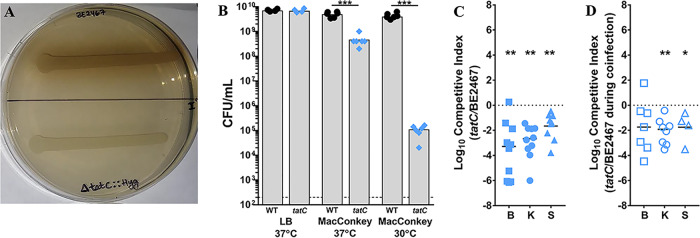FIG 9.
Twin arginine translocation contributes to P. stuartii fitness during single-species and polymicrobial CAUTI. P. stuartii BE2467 and the isogenic tatC mutant were assessed for pigment production (A), susceptibility to bile salts on MacConkey agar (B), fitness during single-species infection (C), and fitness during coinfection with P. mirabilis HI4320 (D). (A) Representative image of pigment production by wild-type P. stuartii and the tatC mutant on LB agar supplemented with tyrosine and iron sulfate. (B) Levels of viable P. stuartii BE2467 and the tatC mutant (CFU/ml) following incubation on LB or MacConkey agar at 37°C or 30°C. Gray bars represent the mean levels of CFU/ml from 3 independent experiments performed with 2 replicates each. Statistical significance was assessed by Student's t test (***, P < 0.001). (C) CBA/J mice (n = 10) were transurethrally inoculated with 1 × 105 CFU of a 1:1 mixture of wild-type P. stuartii and the tatC mutant, a 4-mm segment of catheter tubing was retained in the bladder for the duration of the study, and a competitive index was calculated as described above. (D) CBA/J mice (n = 8) were transurethrally inoculated with 1 × 105 CFU of a 1:1:2 mixture of wild-type P. stuartii, the tatC mutant, and wild-type P. mirabilis HI4320. A competitive index was again calculated for the tatC mutant relative to wild-type P. stuartii BE2467 to determine fitness of the mutant during coinfection. Statistical significance was assessed by Wilcoxon signed-rank test (*, P < 0.05; **, P < 0.01).

